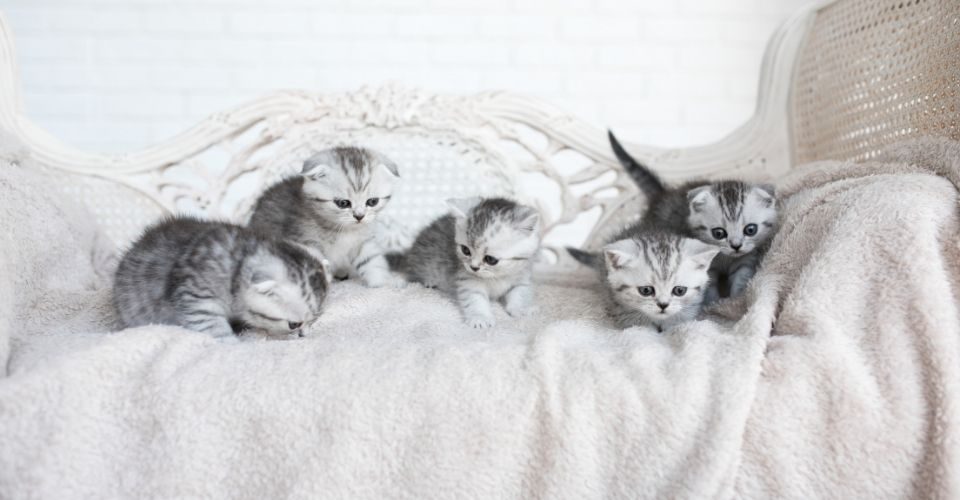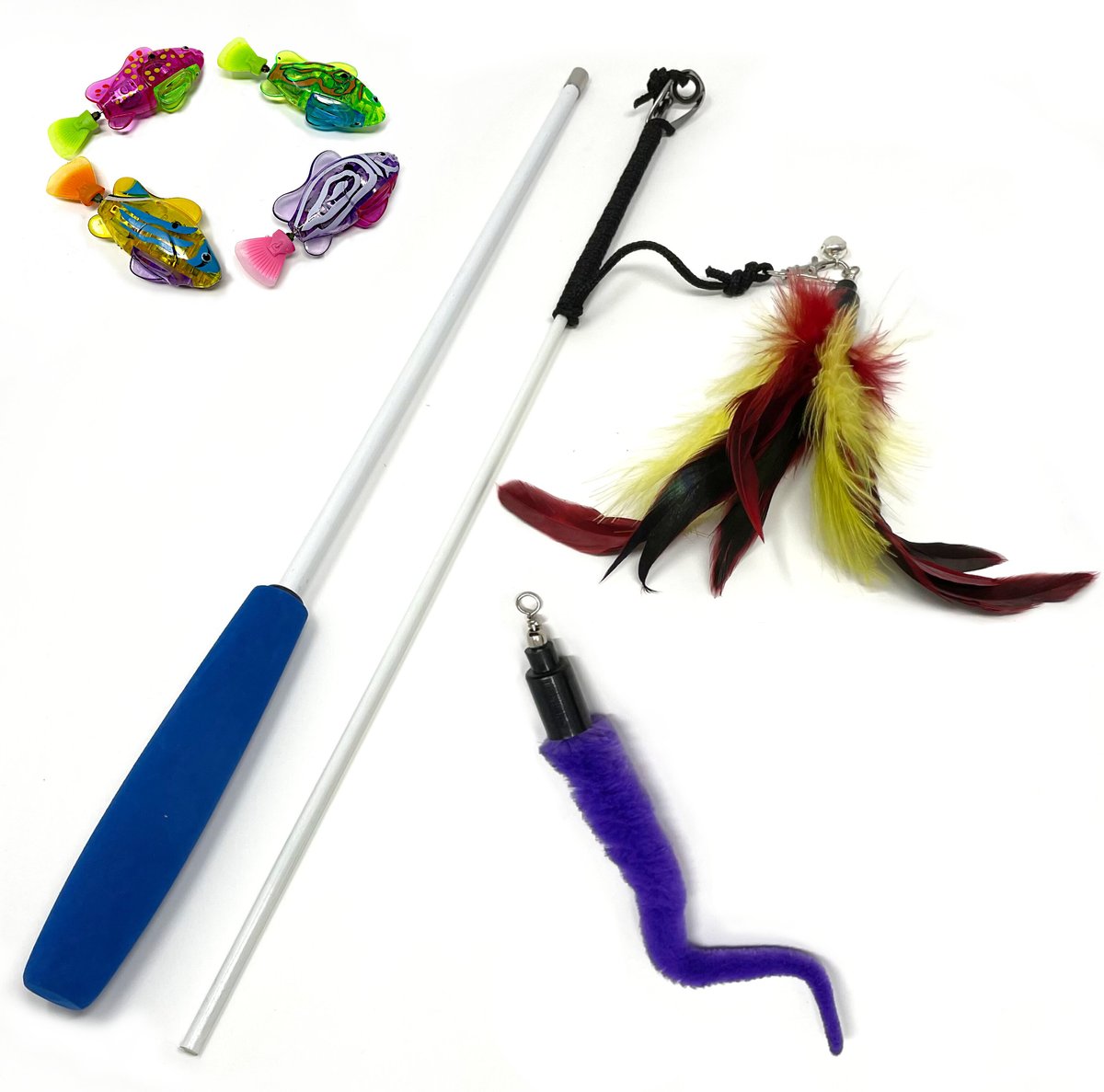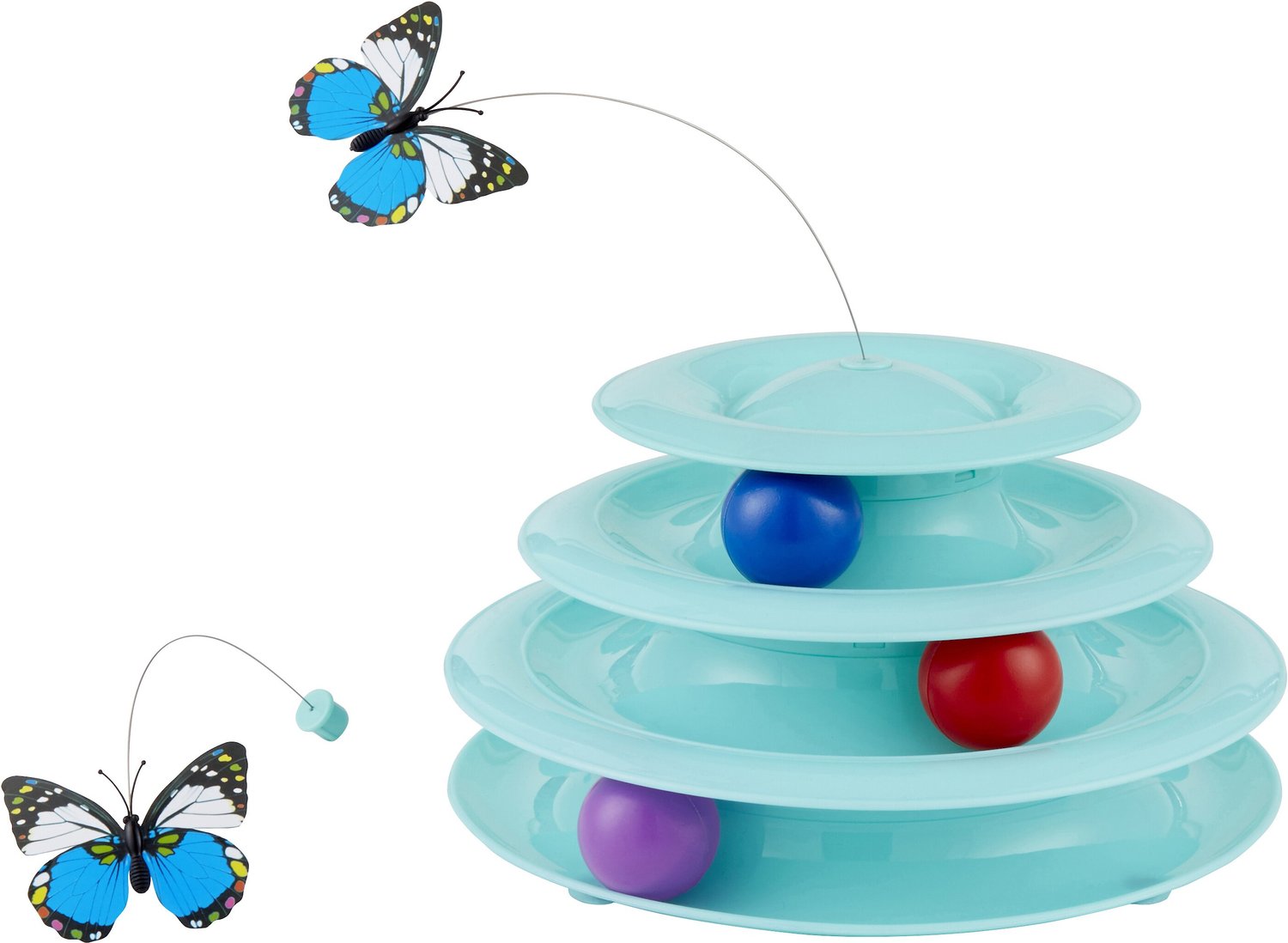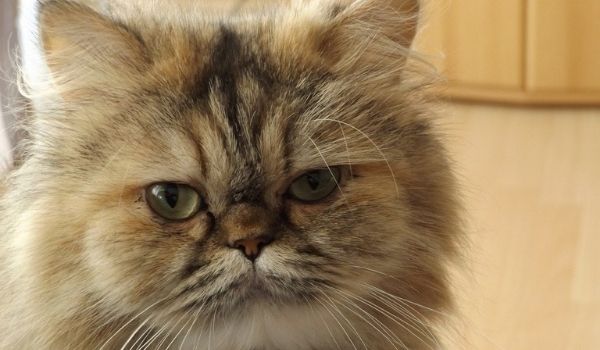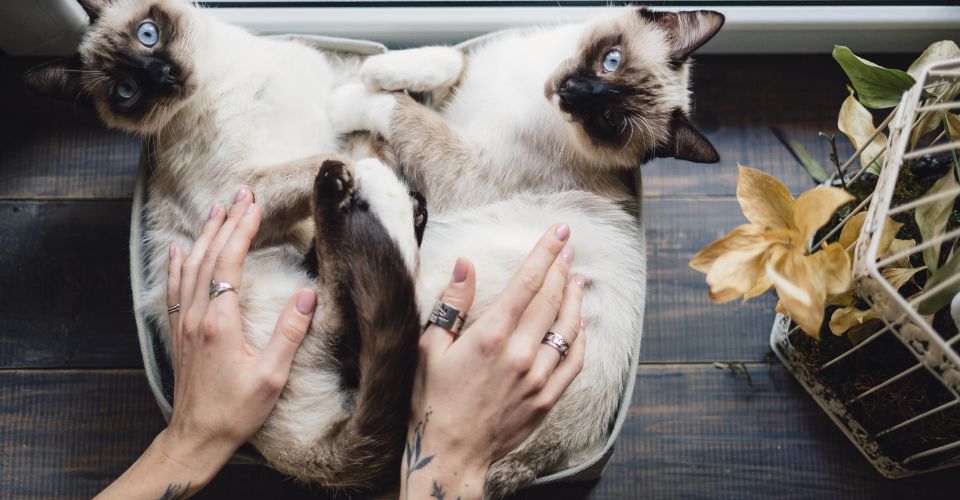Cat comes in various colors ranging from grey to pure white and black to orange. Though all cats are adorable irrespective of the color of their skin, different people have different preferences. Some have a thing for tabby cats, and others find brown cat breeds adorable, and yet others are fascinated by calico cats. What about you? What is your favorite cat breed?
Perhaps, one of the grey cat breeds?
Grey Cat Breeds
The moon-colored grey cat breeds are quite popular among feline lovers across the world. Perhaps, you have been wooed by a grey cat as well, and now you are looking for a grey cat breed that will make a perfect pet for you. Well, here are some of the most popular grey cat breeds.
1. Chartreux
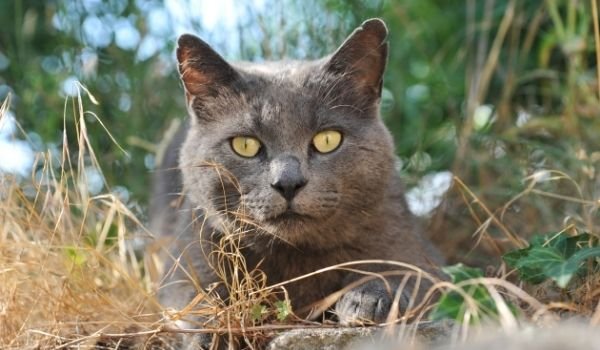
Breed Overview
Height:9 to 11 inches
Weight: 6 to 14 pounds
Lifespan: 12 to 15 years
Temperament: Highly sociable, loving, active, playful
Suitable for: Multi-pet households, families with children, active cat parents, not for people with allergies
Originating from the Middle Eastern region, Chartreux is one of the rarest cat breeds, having only a handful number of active breeders. They have a robust body with thin legs. That is why they are often described as “a potato on toothpicks.” They have a dense and water-repellent coat of blue-gray shade, making them swimming cats. Where most cats hate water, Chartreux don’t hate water; rather, the opposite—they love water and look forward to their bathing sessions.
Born as hunting cats, Chartreux are very agile and active cats. They love to jump and climb on things—bring them home only if you won’t mind them climbing on doors and shelves. They won’t even feel guilty if they break a thing or two while climbing and jumping. To keep these cats off furniture and doors, you can try bringing them cat trees and interactive toys.
They are pretty energetic cats and will be needing a lot of exercise to stay in good shape. They shed a lot; if you are allergic, bringing them home won’t be a good idea. Weighing 6 to 14 pounds, they have an average lifespan of 12 to 15 years.
Despite being a born hunter and energetic, Chartreux are not confrontational—when a conflict arises, they tend to leave the scene. They easily get along with children as well as dogs. So if you have a canine companion and are looking to add a feline member to your family, Chartreux has to be your buddy.
2. British Shorthair
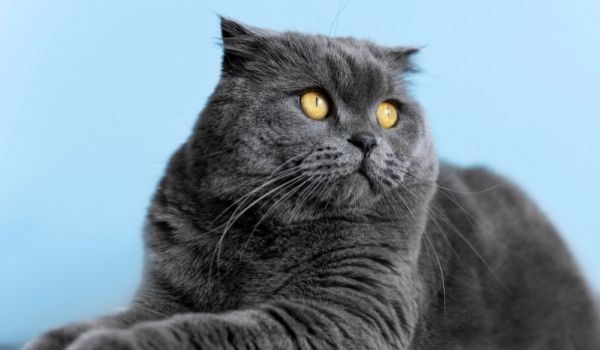
Breed Overview
Height:12 to 14 inches
Weight: 7 to 17 pounds
Lifespan: 15 to 20 years
Temperament: Highly sociable, affectionate, easygoing
Suitable for: Families with children, multi-pet households
The name suggests that the breed must have originated from Britain, but it is not the case—the British Short-hair cat breed was only refined in Britain in the 19th century. Before that, it was called moggy in Britain. They hold the historical title of being the first official show cat.
Known as Bulldog of the feline world, British Shorthair cats have a massive head, thick neck, broad ears, and big round eyes. Because of their big round eyes, they are often grouped with cat breeds with big eyes. They have a lifespan of 15 to 20, and their weight may vary between 7 to 17 pounds and take up to 5 years to reach full physical maturity. They come in a wide variety of colors and patterns, but their trademark is a blue coat with a shade of grey.
They are prone to grow obese, so their pet owners should take help from a kitten feeding chart and kitten growth chart, to track the development and growth of their British Shorthair kittens. If a kitten seems not to be overweight or underweight than the average weight, you should discuss it with your vet and chalk out a custom-made diet plan. Along with an appropriate diet, they also need a lot of exercises to burn their calories and stay in shape.
3. Russian Blue
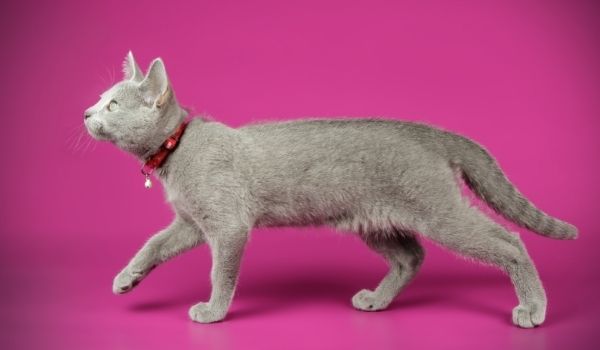
Breed Overview
Height:9 to 11 inches
Weight: 7 to 12 pounds
Lifespan: 15 to 20 years
Temperament: Loyal, affectionate, withdrawn around strangers, energetic and playful
Suitable for: People with allergies, multi-pet households, first-time cat owners
As suggested by its names, the Russian blue cat breed is believed to have originated from Russia. It is said that British sailors were fascinated by the captivating eye color of Russian blue and thus brought a pair home. Russian blues love to be in quiet surroundings and quickly adapt to being alone—just provide them some toys to play with. They also love to chase sunbeams. This feature makes it a perfect choice for working cat owners who have to leave their cats home alone while going to work. However, it is not that they won’t enjoy an interactive playtime session with their owners—if you have free time, they would love to play fetch with you.
The most enchanting feature of this cat breed is their silky double coat, which makes them look bigger than they actually are and have a shimmering look. Their silky coat, combined with vivid green eyes, never fails to fascinate viewers. They love to snuggle in their owners’ laps and enjoy belly rubs. Russian blue cats are incredibly intelligent, and therefore, are quite easy to be trained. Their average lifespan is 15 to 20 years, and they weigh from 7 to 12 pounds.
These cats shed very little and produce very little of the allergen Feld d1, which is responsible for triggering allergic reactions in people with allergies. For this, they are considered one of the hypoallergenic cat breeds and make a perfect choice for people with allergies.
4. Korat
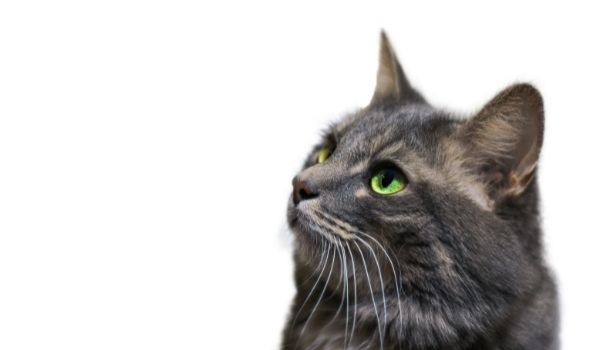
Breed Overview
Height:9 to 13 inches
Weight: 6 to 10 pounds
Lifespan: 10 to 15 years
Temperament: Highly intelligent, social, affectionate, talkative
Suitable for: People with allergies, first-time cat owners, multi-pet households
If you think you could use some luck, adopt a Korat.
Nicknamed as “Good Luck Cat,” Korat originates from Thailand, where it is associated with good luck. According to feline fables, the chances of getting lucky increase when Korats happens to have a kink in their tails. Korat was brought to the US by the American soldiers on their return from the Vietnam War. They have an average life span of 10 to 15 years and may take up to 5 years to reach their full size. A healthy Korat should weigh between 6 to 10 pounds. These cats don’t shed much and thus are often listed as hypoallergenic cat breeds.
Korats are highly intelligent cats and are said to engage in conversations by making expressive sounds. They can also open kitchen cabinets by pawing. Due to their intelligent nature, they quickly learn tricks and problem-solving skills. They also memorize which actions earn them a delicious treat and which could bring reprimand their way. Cat clicker training would be a perfect way to train them how to walk on a leash and many other basic and advanced tricks.
Korats have a deep lustrous, blue-grey coat and luminous green eyes. Like Chartreux, Korats are also one of the rare cat breeds and are quite hard to find.
5. American Shorthair
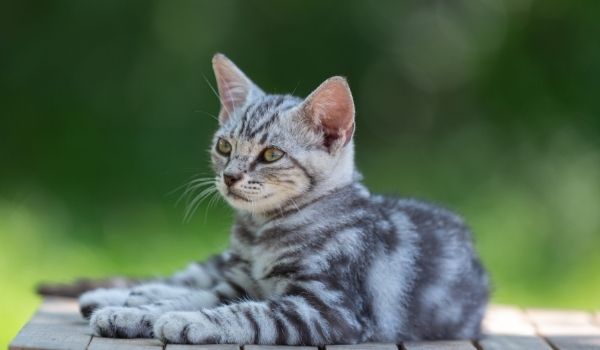
Breed Overview
Height:8 to 10 inches
Weight: 10 to 15 pounds
Lifespan: 15 to 20 years
Temperament: Gentle, affectionate, friendly, easygoing
Suitable for: Families with children, multi-pet households, first-time cat owners
American Shorthairs came to America along with the European settlers in the famous Mayflower in the 16th century. They were brought along to deal with mice and rodents on the ship. Originally known as Domestic Short-hair cat, they were only renamed American Shorthair in 1966. With a lifespan of 15 to 20 years, American shorthair falls among the list of long-living cat breeds.
American Shorthair cats are one of the most popular cat breeds with stripes—they have a silver-grey coat with black stripes running parallel to their spine. Their dense coat enables them to weather harsh environments. This is probably the reason that helped them survive the cold nights of harsh winters and dog days of blistering summers.
These cats love to snuggle up with their favorite person—you would often find them lying in bed with you or sleeping on top of you. This is their way of showing their love for you. American shorthair makes a perfect pet as they easily get along not only with children but also dogs in the house.
6. Nebelung
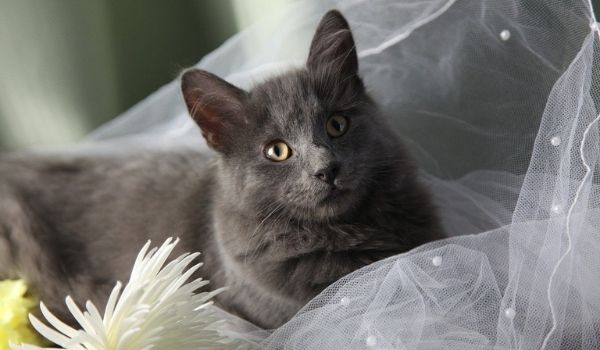
Breed Overview
Height:9 to 13 inches
Weight: 7 to 15 pounds
Lifespan: 11 to 18 years
Temperament: Loyal, affectionate, a bit reserved
Suitable for: Single pet household, working parents, families with children
This is relatively a new cat breed, developed only in the 1980s. They like being pampered, snuggling in their owners’ lap, and belly rubs. They have a soft double coat, grey colored with silver tips, giving them a fluffy, shiny look. Their yellow-green eyes further add to their enchanting looks. Owing to their captivating appearances, they are named Nebelung, which means “creature of the mist” in German.
Nebelungs are loving and loyal cats. When brought home, they may take their time in establishing a bond with their owners, but once the rapport is built, they will be following you around in every corner of the house. However, when it comes to strangers, they are a bit reserved—often hiding on the arrival of a guest. They make a perfect choice for working cat parents. You can just get them some toys, a comfy cat bed, and maybe a cat window perch for them to snuggle in and soak up all the sunlight.
7. Scottish Fold
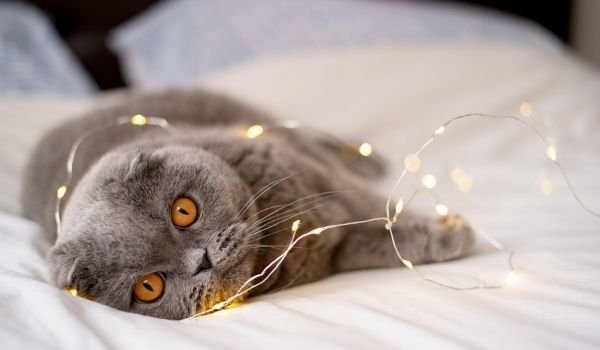
Breed Overview
Height:8 to 10 inches
Weight: 6 to 9 pounds
Lifespan: 11 to 14 years
Temperament: Easygoing, affectionate, calm, adaptable
Suitable for: Multi-pet households, families often having guests over, working parents
Did you know that among three Taylor Swift cats, two are Scottish Folds?
Yes, she is a feline fanatic and has three feline members in her family. Two of them are Scottish Fold, Meredith Grey and Olivia Benson and the third one is a Ragdoll cat, Benjamin Button.
Originating from Scotland, Scottish Folds have folded ears, hence the “fold” in their name. These are medium-sized cats and come in both shorthair and long-hair versions. They have a round face and eyes and short neck on a sturdy body with a puffy tail. They have an average lifespan of 11 to 14 years.
With celebrities like Taylor Swift adopting Scottish Folds, they have experienced an uptick in their popularity across the United States. These fluff balls love to sleep in their owners’ laps while enjoying soothing belly rubs. These cats are very adaptable and get along with not only other pets but also young children. They also adjust to new changes without much drama.
Scottish folds are known for having several health issues due to their genetic makeup. This is why the Governing Council of the Cat Fancy (GCCF) has been maintaining a ban on this breed since 1970. But in the US, there is no such ban, and you can easily get yourself a Scottish fold if you want to. However, you should never breed a Scottish fold with another Scottish fold as it would increase the chances of developing congenital diseases.
8. Norwegian Forest Cat

Breed Overview
Height:9 to 12 inches
Weight: 9 to 16 pounds
Lifespan: 15 to 20 years
Temperament: Intelligent, friendly, calm, gentle, and outgoing
Suitable for: Families with children, multiple pet households, outgoing cat parents
This is an ancient cat breed—more than thousands of years old. These are said to have come to the new world from Norway, accompanying Vikings.
Norwegian Forest cats have a double coat. With dense long-flowing hair coats, they are classified as one of the fluffiest cat breeds. This unique coat has helped them survive the harsh Norwegian climate—sunless winters and moonless summers. They come in a variety of colors, ranging from pure white to coal black.
Their double coat with long-flowing hair requires regular grooming—at least twice a week—to prevent hairballs. Their shedding patterns change with the season; during the dog days of summer, they shed so much that they start resembling shorthair cats.
Norwegian cats love the company of children as well as other pets, such as dogs and cats. Despite living for ages in the wild and having a rugged appearance, they are very affectionate and loving creatures. That said, Norwegian Forest cats love to jump around, so expect them to treat your house like a jungle—jumping and climbing on things. If you do not want that, according to the CFA, you should bring them scratching posts, cat trees, and interact cat toys to expend all their pent-up energy.
9. Sphynx
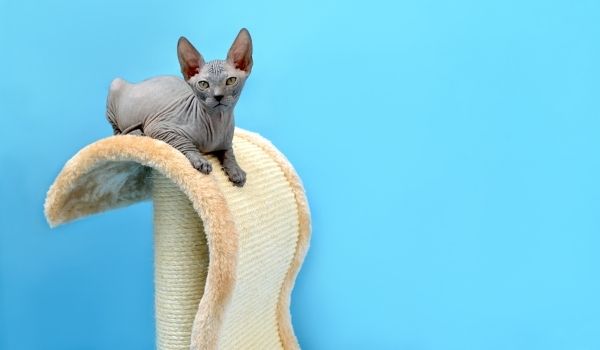
Breed Overview
Height:8 to 10 inches
Weight: 6 to 14 pounds
Lifespan: 9 to 15 years
Temperament: Bold, social, chatty, playful, snuggly
Suitable for: People with allergies, multi-pet households
These hairless cats never fail to capture the attention of viewers. They came into being as a result of a natural mutation. The present-day Sphynx is traced back to two lines of mutant kittens found in Minnesota and Toronto. These are extremely friendly and easily trainable cats.
Unlike other cats, Sphynx enjoys their bathing sessions. They actually need regular baths. Their furless body secretes oils that attract dust. Some often suggest daily sponging. After the bathing session, they immediately rush towards a warm place. Having an average lifespan of 15 to 20 years, they are considered one of the long-living cat breeds. Of all the grey cat breeds, Sphynx is one of the cat breeds that don’t shed.
If your allergies have been keeping you from owning a pet, then Sphynx will be a perfect match for you—they have no hair to shed.
10. Persian Cat
Breed Overview
Height:10 to 15 inches
Weight: 7 to 12 pounds
Lifespan: 15 to 20 years
Temperament: Sociable, affectionate, calm, and sweet
Suitable for: Families with a clam and quiet household, calm and lazy parents
Having a bit murky history, Persian cats have been around since the seventeenth century. Because of their fluffy coats, calm and sweet nature, Persian cats are one of the most popular cats in the United States and the fourth most popular cat breed in the world, according to the CFA. They are one of the cutest flat-face cat breeds. Where their flat face earns them popularity among feline lovers, it also makes them more susceptible to feline upper respiratory infection.
Persian cats are cute and all, but before you decide on bringing them home, you should keep in mind that they require a lot of grooming. They shed a lot and would require regular brushing—daily to at least twice or thrice a week. On some days, you might have to brush their coat more than once. If not kept with great care, their undercoat will knot, which will convert into mats that are quite painful to remove. So bring them home if you are up for the grooming duties.

